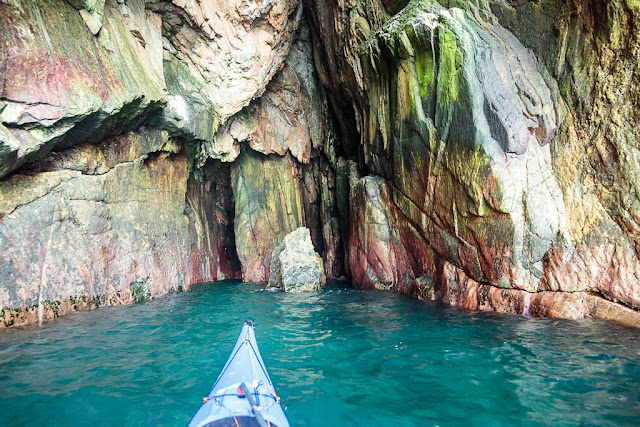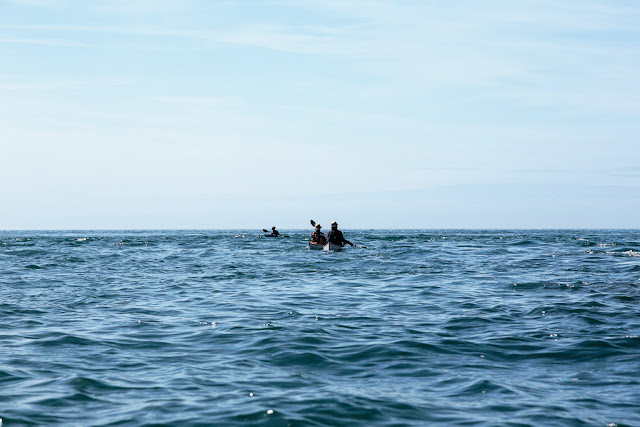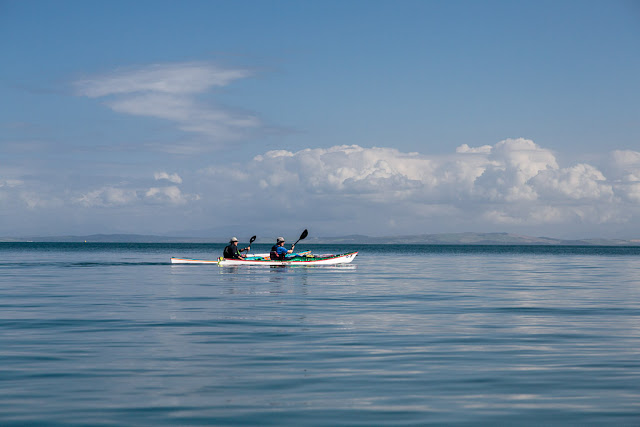At the Mull of Logan there are a number of hidden inlets which lead to the great rock arch called the Devil's Bridge. Phil, Tony and I had been before but as Maurice had not been before (and we had said nothing to him) he amazed when he found it.
Those entering the recesses and passing under bthe arch do so under the baleful stone gaze of the Old Man of the Mull of Logan.
We dallied for some time in this wonderful spot but the tide was still rushing north and we were now going to head south to Port Logan...
...against the tide. There was no eddy on the SE side of the Mull but close in the tide was only running at 4km/hr compared with 9km/hr just a few meters out.
Soon we were in quiter waters and the coast here has a maze of gullies many of them interconnecting. This arch is called Little Bridge.
Further along we came to this old cabin before we arrived...
...in Port Logan Bay which is backed by the fertile fields of the Rhins of Galloway.
Our final obstacle was clearing the lines of the many fishermen who lined the old pier. Port Logan was originally called Port Nessock and in the 1
7th century attempts were made by the McDouall family to establish it as a ferry port for Ireland. They also built the Port Logan Inn which is sadly closed at the moment.
The quay and Port Logan Light were built in 1830 by Colonel Andrew McDouall. The light is a conical stone tower with a platform for a lantern. It is not known when it was last lit but for sometime after that it had a bell, which was rung to guide local boats back in foggy conditions. A decent road to the village was not constructed until the early 20th century, so most of the village's trade and traffic depended upon the sea. A life boat station was built at Port Logan in 1866. It closed in 1932 as the RNLI lifeboat at Portpatrick, 18km to the north west, was motorised by then. The boat house is now the village hall which you can find near the quay.
Our 24km trip from the East Tarbet round the Mull of Galloway, Crammag Head and the Mull of Logan is one of the finest paddles in Scotland. However, due to the tides it can be very serious if there is any wind.
Imagine you are at the edge of the sea on a day when it is difficult to say where the land ends and the sea begins and where the sea ends and the sky begins. Sea kayaking lets you explore these and your own boundaries and broadens your horizons. Sea kayaking is the new mountaineering.
Showing posts with label Mull of Galloway. Show all posts
Showing posts with label Mull of Galloway. Show all posts
Wednesday, October 28, 2015
Saturday, October 10, 2015
Lobsters, tides, caves and headlands on the Rhins of Galloway.
We were not the only ones going round the Mull of Galloway that day...
...Tony Patterson and crew in BA852 Valodest were...
also taking advantage of the calm and slack water to lift their lobster pots.
We decided not to land at West Tarbert as there were "wild" campers in residence. I am surprised there is any grass left there. Everyone makes a fresh fire ring on the grass.
Instead we proceeded north up the west coast of the Rhins of Galloway ...
...along an amazing coastline and soon...
...we had left the Mull of Galloway and its lighthouse far behind.
As we crossed Carrickamickie Bay the tide began to pick up until...
...there were standing waves and a slope on the water at a gap off Carrickallan Point.
Beyond the point we entered a calmer eddy and then came to a series...
...of caves, at Carrickahawkie,...
...Slocknagower and...
......Port Mona.
By now we could see Crammag Head, the next bit of tidal fun but we decided to stop for first luncheon to let the tide build up a bit....
...Tony Patterson and crew in BA852 Valodest were...
also taking advantage of the calm and slack water to lift their lobster pots.
We decided not to land at West Tarbert as there were "wild" campers in residence. I am surprised there is any grass left there. Everyone makes a fresh fire ring on the grass.
Instead we proceeded north up the west coast of the Rhins of Galloway ...
...along an amazing coastline and soon...
...we had left the Mull of Galloway and its lighthouse far behind.
As we crossed Carrickamickie Bay the tide began to pick up until...
...there were standing waves and a slope on the water at a gap off Carrickallan Point.
Beyond the point we entered a calmer eddy and then came to a series...
...of caves, at Carrickahawkie,...
...Slocknagower and...
......Port Mona.
By now we could see Crammag Head, the next bit of tidal fun but we decided to stop for first luncheon to let the tide build up a bit....
Tuesday, October 06, 2015
The Mull of Galloway, Scotland's most southern coast.
From Lunnock Caave we paddled towards Carrickcarlin Point which...
...lies below the Mull of Galloway lighthouse and its foghorn.
A characteristic feature of the Mull of Galloway cliffs is the bright yellow lichen. In spring and early summer this is spattered by the white of the sea bird colonies guano.
Carrickcarlin Point is one of the four most southerly points in Scotland.
The south coast of the Mull runs east west and from Carrickcarlin Point in the east this is the view...
...to the west showing Lythe Mead, Gallie Craig and just the shoulder of Carrick Kee.
I paddled out to get a decent view of...
...the lighthouse which is hidden from the base of the cliffs.
Below the foghorn is the entrance to...
...Seals Cave which is big enough to drive...
...several double decker buses in. The depths of the cave were very colourful.
Lythe Mead lies directly below the visitor centre and unsurprisingly they claim this to be the most southerly point in Scotland.
This is the view from Lythe Meade back east to Carrickcarlin Point.
Beyond Lythe Mead there is a deep geo called Foxes Rattle. This is looking out at Lythe Mead and the stack Inchshannoch.
This is the head of the Rattle and...
...this is a cave in its north west wall.
The next headland we came to was Gallie Craig.
Beyond the Craig the tide was already running strongly towards the west.
This is the view from Gallie Craig looking back...
...towards Lythe Mead and Carrick carlin Point.
At the Gallie Heughs we got our last view back to the lighthouse which is hidden from view from...
...the fourth headland at Carrick-Kee. So which of these headlands is the furthest south? Well it is a close run thing but the sea was so calm I was able to touch each headland. These are the northings from my GPS unit:
Carrickcarlin Point N54 38.026
Lythe Mead N54 38.013
Gallie Craig N54 37.999
Carrick-Kee N54 37.989
So Carrick-Kee just makes it as the most southerly point in Scotland based on latitude. That is further south than the mouth of the River Tees on England's east coast!
Note that the OS grid north is canted with respect to true north and the most southerly point with respect to grid north may be different.
Beyond Carrick-Kee the interest continued with more cliffs...
...and caves.
At Carrickcorrie you will turn NW and see the north shore of West Tarbet Bay. When the west going stream is running along the south coast of the Mull of Galloway you will encounter an adverse SE going eddy at this point. If it is windy from the NW it can be hard work breaking through this.
...lies below the Mull of Galloway lighthouse and its foghorn.
A characteristic feature of the Mull of Galloway cliffs is the bright yellow lichen. In spring and early summer this is spattered by the white of the sea bird colonies guano.
Carrickcarlin Point is one of the four most southerly points in Scotland.
The south coast of the Mull runs east west and from Carrickcarlin Point in the east this is the view...
...to the west showing Lythe Mead, Gallie Craig and just the shoulder of Carrick Kee.
I paddled out to get a decent view of...
...the lighthouse which is hidden from the base of the cliffs.
Below the foghorn is the entrance to...
...Seals Cave which is big enough to drive...
...several double decker buses in. The depths of the cave were very colourful.
Lythe Mead lies directly below the visitor centre and unsurprisingly they claim this to be the most southerly point in Scotland.
This is the view from Lythe Meade back east to Carrickcarlin Point.
Beyond Lythe Mead there is a deep geo called Foxes Rattle. This is looking out at Lythe Mead and the stack Inchshannoch.
This is the head of the Rattle and...
...this is a cave in its north west wall.
The next headland we came to was Gallie Craig.
Beyond the Craig the tide was already running strongly towards the west.
This is the view from Gallie Craig looking back...
...towards Lythe Mead and Carrick carlin Point.
At the Gallie Heughs we got our last view back to the lighthouse which is hidden from view from...
...the fourth headland at Carrick-Kee. So which of these headlands is the furthest south? Well it is a close run thing but the sea was so calm I was able to touch each headland. These are the northings from my GPS unit:
Carrickcarlin Point N54 38.026
Lythe Mead N54 38.013
Gallie Craig N54 37.999
Carrick-Kee N54 37.989
So Carrick-Kee just makes it as the most southerly point in Scotland based on latitude. That is further south than the mouth of the River Tees on England's east coast!
Note that the OS grid north is canted with respect to true north and the most southerly point with respect to grid north may be different.
Beyond Carrick-Kee the interest continued with more cliffs...
...and caves.
At Carrickcorrie you will turn NW and see the north shore of West Tarbet Bay. When the west going stream is running along the south coast of the Mull of Galloway you will encounter an adverse SE going eddy at this point. If it is windy from the NW it can be hard work breaking through this.
Wednesday, September 30, 2015
All calm in the Lunnock Cave at the Mull of Galloway.
The 16th dawned to be one of the few sunny, calm days in August. It was ideal for a trip to the Mull of Galloway.
Tony and I dropped a shuttle car at Port Logan on the west coast of the Rhins of Galloway then met Phil and Maurice at the East Tarbet. Inshore, the west going ebb starts at -1:30 HW Dover. HW Dover was at 13:10 so slack water was at 11:40 and we launched bang on time at 11:10.
The NE side of the Mull is a grassy slope and gives very little warning of the dramatic rock architecture beneath the lighthouse just 500m away on the other side of the peninsula.
The waters of Luce Bay to the NE were calm unlike a previous visit when we hit the Mull at maximum tidal flow!
We rounded the critical point at Lagvag at slack water and entered the Lunnock Cave...
...for a celebratory exploration. If you do get caught out in the Mull of Galloway tide race, the Lunnock Cave would make a marvellous place to wait for calmer conditions as the...
.
...vicious eddylines at its mouth kill the swell.
Tony and I dropped a shuttle car at Port Logan on the west coast of the Rhins of Galloway then met Phil and Maurice at the East Tarbet. Inshore, the west going ebb starts at -1:30 HW Dover. HW Dover was at 13:10 so slack water was at 11:40 and we launched bang on time at 11:10.
The NE side of the Mull is a grassy slope and gives very little warning of the dramatic rock architecture beneath the lighthouse just 500m away on the other side of the peninsula.
The waters of Luce Bay to the NE were calm unlike a previous visit when we hit the Mull at maximum tidal flow!
We rounded the critical point at Lagvag at slack water and entered the Lunnock Cave...
...for a celebratory exploration. If you do get caught out in the Mull of Galloway tide race, the Lunnock Cave would make a marvellous place to wait for calmer conditions as the...
.
...vicious eddylines at its mouth kill the swell.























































